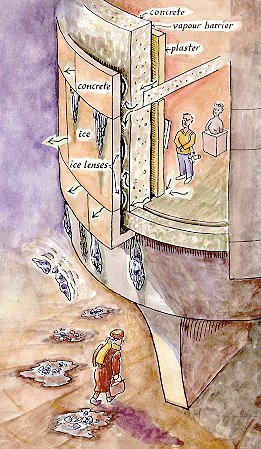
 |
Condensation in the walls of humidified buildings - 3 |
It is very often only some unusual weather that reveals the magnitude of processes that are continuing invisibly in less extreme weather. My last example is from the building next to the Arts and Industries Museum: the Hirshhorn Museum of Modern Art.
 This is a much more modern structure, with a moisture barrier built in from the start, and probably leaky from the start.
This is a much more modern structure, with a moisture barrier built in from the start, and probably leaky from the start.
I was passing by on a cool but bright spring morning and witnessed the building dropping lumps of ice on innocent workers hurrying to their duties in the Federal service.
The museum is a large cylinder on legs. The humidified, filtered and pressurised air that is attempting to compensate for the doubtful durability of much of the art, leaks out through defects in the sealing. Water often condenses behind the concrete outer skin. On the previous night the water condensed as ice. When the morning sun warmed the grey concrete walls the ice melted and flowed through the joints to the outside of the wall where it froze again by evaporative cooling from the strong breeze and the low relative humidity in the air.
As the sun grew stronger its radiation melted first the ice in contact with the wall, so large chunks fell away and littered the pavement below.
The message from this, and many other similar examples, is that complicated structures will never be built accurately enough to realise the intentions of their designers.
I have never seen comparable phenomena in the simple, solid walls of uninsulated, porous brick that are typical of older houses that are used as museums. This must be because the fine balance of processes described in part 1 of this article results in a wall that is seldom wet, even in very cold weather.
It seems to me that museum designers should be investigating the advantages of walls of homogeneous, porous material with thermal insulation distributed evenly right through the wall section. This will avoid the cracks, steep temperature gradients and impermeable layers that cause water to accumulate. It will also tend to make walls that have a large thermal inertia, which provides extra stability to the inside climate.

This work is licensed under a Creative Commons Attribution-Noncommercial-No Derivative Works 3.0 License.